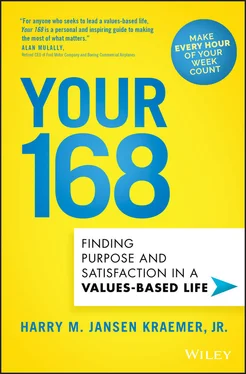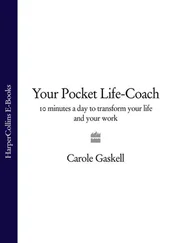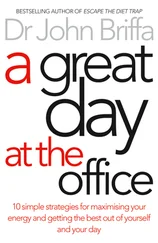Over the course of a week, though, our days tend to fall into a pattern. And even if a week is an anomaly—for example, five straight days of business travel—over a few weeks we can see how our time allocation is shaping up. A tool that helps is the life grid, composed of components or what I call life buckets, those areas into which you pour your time, attention, and energy.
Table I.1 provides a representation of where and how I want to spend my time and enables me to record how I actually spend my 168 hours a week.
Your life grid may not look like someone else's. And it's not what you think your 168 should look like. This is your 168—allocated to reflect your priorities, choices, and life circumstances. Being honest and accountable to yourself is fundamental to living a values-based life—otherwise, you're just deceiving yourself, and where's the benefit in that?
Once you have a life grid of how you want to allocate your time, you can start tracking how closely your life follows that plan (see chapter 2). Not every week will be on target. But over time, the goal is to balance your life by keeping track of how you spend your time and holding yourself accountable for your 168.
When I discuss 168 with people, I tend to get two reactions. First, there are those who engage with the idea. They embrace the concept of life buckets to see where they're above or below their goals. They know that no two weeks will be the same. They're traveling on business one week, so they don't have as much time with family. However, while traveling, they catch up on reading or put in extra hours on a work project, so that when they're back home they can devote more time to family, friends, leisure, and exercise. It's not about beating themselves up; it's about striving to maintain an average over time.
Table I.1 One example of a life grid with targeted time allocations for each bucket.
| Life Bucket |
Goal Hours |
Actual Hours Spent |
Difference |
| Career |
50 hours (30%) |
|
|
| Family |
28 hours (17%) |
|
|
| Faith/Spirituality |
11 hours (7%) |
|
|
| Health/Sleep |
55 hours (32%) |
|
|
| Fun/Recreation/Reading |
14 hours (8%) |
|
|
| Making a Difference |
10 hours (6%) |
|
|
| 168 hours (100%) |
The second reaction from people who hear me discuss 168 is to say, “Wow, that's amazing.” (I'm always amused by this reaction because there's nothing that amazing about multiplying 24 hours in a day by 7 days in a week.) What they really mean, I suspect, is that they have no clue as to how they spend their time. They probably haven't taken the time to identify their values and priorities, either. This isn't meant to judge anyone; it's just a fact that not everyone operates with the same level of self-awareness. I can tell you, based on the talks I've given on values-based leadership for the past 15 years, there is a great hunger among people to get their lives back in control with a sense of balance.
That's the goal of Your 168: Finding Purpose and Satisfaction in a Values-Based Life . For everyone who wants to live a life with more purpose, meaning, engagement, satisfaction, and fun, 168 should be your favorite number, too.
THE VALUES-BASED LEADERSHIP JOURNEY
For the past 15 years, I have been teaching, writing, and speaking about values-based leadership. In my first book, From Values to Action: The Four Principles of Values-Based Leadership, I addressed how anyone at any level can become a values-based leader by following four foundational principles:
Self-reflection to identify and reflect on what you stand for, what your values are, and what matters most
Balance to see situations from multiple perspectives, including differing viewpoints, to gain a holistic understanding
True self-confidence to accept yourself and recognize your strengths and weaknesses, while focusing on continuous improvement
Genuine humility to never forget who you are, appreciating the unique value of each person and treating everyone with respect
From becoming a values-based leader, the next step was to develop a values-based organization, which was the subject of my second book, Becoming the Best: Build a World-Class Organization through Values-Based Leadership . This book explored the “five bests” starting with becoming your best self. From there, it's about forming the best team within the organization, being the best partner with customers and suppliers, being recognized as a best investment, and committing to social responsibility as a best citizen.
With the publication of these two books, I have traveled the world delivering more than 1,000 talks (and counting) to several hundred thousand people. The message of values-based leadership resonates as much in the US as it does in Europe, Latin America, and Asia. It applies equally to people in all fields: technology, health care, financial services, retail, academics, and philanthropy. For people at every level—from the CEO to people starting out in their careers and those who are still in school—being a values-based leader in a values-based organization will enhance their lives.
There are challenges. In fact, with every talk I give, people tell me, “This sounds great, Harry, but I'm not sure how I can get all this done. I have so many things going on. How can I do this?”
My answer is this latest book: Your 168: Finding Purpose and Satisfaction in a Values-Based Life .
This book is divided into two parts. The first is “Defining Balance.” This part begins with the foundation of every values-based leadership discussion: self-reflection. When people tell me that they are having trouble balancing their lives, it's usually because they aren't being self-reflective enough to determine what they are trying to balance. You can only gain clarity on personal and professional issues in your life by thinking more deeply about them. The more self-reflective you are, the easier it is to make choices that are aligned with your values.
Over time, as you become more self-reflective, there are fewer reasons for you to be surprised, which is the next topic of discussion. When people have no idea where and how they spend their time, they're often surprised—and not in a good way. They're suddenly surprised when a relationship fails, friendships end, or loved ones die, leaving them with regret over the time they didn't spend together. At the same time, I know many people who have made meaningful changes in the quality of their lives simply by becoming more aware and eliminating those surprises.
When surprises go unheeded, they don't just fade away. Without the self-awareness that comes from self-reflection, a relatively minor surprise or small problem compounds into a major upset—and you hit the brick wall. Now you've got a full-blown crisis on your hands. As I've seen among people I know, including those who have shared their life journeys with me, these crises often spill over into numerous areas: a major relationship is in turmoil, someone's health suffers, a job is in jeopardy. When you hit a brick wall, it can cause wreckage everywhere in your life.
Next, we'll talk about building new habits, which takes both awareness and time. Research tells us that it takes three months on average to build muscle memory (such as engaging in a new exercise routine) and even longer to adopt new health habits or ways of thinking and acting.
The discussion then moves to becoming more planful and constantly reprioritizing. Life doesn't stand still. Priorities and demands change. The only thing that remains constant is 168! Reprioritizing requires you to consider how demands on your time are changing and whether these new demands fit your values. The reward for being more planful is increased flexibility and greater spontaneity. All that discipline in planning and reprioritizing pays off when suddenly there's a surprise opportunity—like two tickets to see your favorite musician in concert—and you can make the time for fun.
Читать дальше












